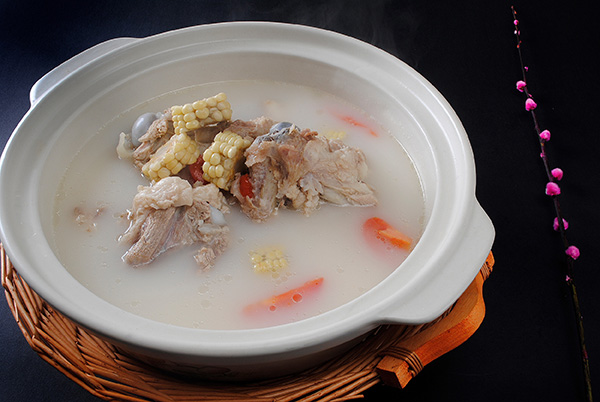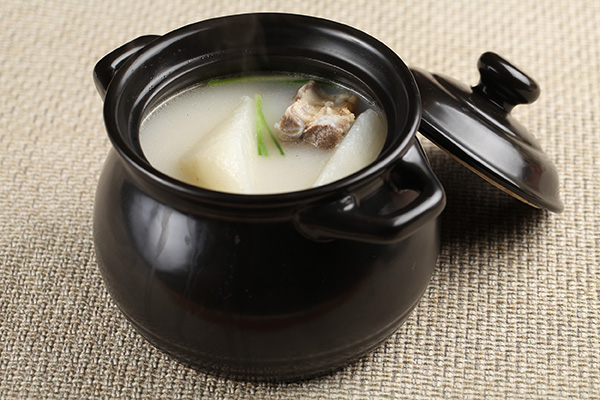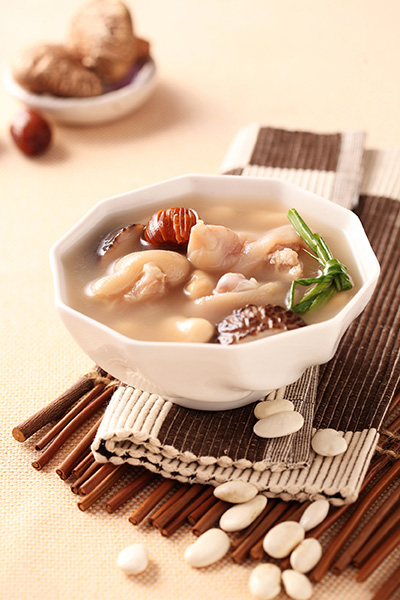


Soup, ranging from the lightest consomme to hearty rich broths with meat and vegetables, is a major category on the menu in Chinese cuisine.[Photo provided to China Daily]
China is divided into as many culinary regions as there are different ethnic groups. Its geographical diversity and kaleidoscopic cultural profiles contribute to the unending banquet of flavors. Pauline D Loh reports.
Soup in Chinese cuisine is a major category on the menu and ranges from the lightest consomme to hearty rich broths that are thick with meat and vegetables.
Of course, no one places more emphasis on soups than the Cantonese, so I will tap into that aspect of my culinary heritage for the classic recipes.
The wok is an important piece of equipment in every Chinese kitchen, but in the Cantonese home, another item holds equal importance: the soup pot.
Normally made of earthenware for its heat-conducting properties, this should be a tall pot with a raised lip that closely cradles the tight-fitting lid.
It should comfortably hold at least four liters of liquid so the soup can slowly reduce. The raised lip helps to keep the lid from rattling and holds in the air pressure that builds up in the long, slow brewing.
Sometimes, more than one soup pot are found in the same kitchen, with a smaller one reserved for a different kind of brew-the medicinal soups so beloved by the Cantonese matriarch.

Soup, ranging from the lightest consomme to hearty rich broths with meat and vegetables, is a major category on the menu in Chinese cuisine.[Photo provided to China Daily]
Not all soups are made in the clay pot. Some of the lighter everyday soups are quickly made, often in the wok.
These are the light soups, made with a few slices of meat for flavor and plenty of vegetables. Mustard greens and lean pork, for example, or even an egg drop soup with coriander added at the last minute.
But the art of making soup reaches its pinnacle with those that are simmered long and slow.
I remember trotters and peanut soup. The broth was rich and milky and scented with the unmistakable aroma of the nuts. The nuts are thrown into the soup with the skins on, and these tinge the soup slightly pink. The trotters, reduced to a gelatinous tenderness, would be plated and served as part of the meal, together with a little saucer of soy sauce. I remember draining the bowl and happily picking at the soft, soft nuts.
Funnily enough, the alchemy of peanuts and trotters means that you hardly taste the porkiness of the pig's feet, only a nutty fragrance that is accentuated by the addition of a handful of dried Chinese jujubes.
And here you have the classic anatomy of a Cantonese soup.
First, you have the meat-which can be pork, beef, mutton or fish. Then you have the complementary ingredients, which can be root vegetables such as radishes, carrots or lotus root, or beans or dried leafy vegetables. And finally, there will always be dried jujubes, dates, ginger, dried citrus peel or any of a vast variety of Chinese herbs.

Soup, ranging from the lightest consomme to hearty rich broths with meat and vegetables, is a major category on the menu in Chinese cuisine.[Photo provided to China Daily]
Every ingredient has a purpose.
The meat will either strengthen or cool the body. The root or leafy vegetables will play supporting roles for flavor or for health. Herbs or aromatics will neutralize certain undesirable effects-like ginger taking away the pungency of fish or pork, and dried jujubes adding sweetness where it is needed.
The long, slow simmering melds the flavors of the various ingredients and allows them to come together in the soup bowl.
Unlike Western soups, the treasured end product is the liquid, the soup, and not the ingredients that first went into the pot. These soup dregs, or tangzha as we call them, are often discarded. In fact, after three hours of simmering, almost all of the flavor has already been extracted.
And there are soups for every purpose.
The Cantonese grandmother's idea of chicken soup is to double boil a minced chicken breast. The result is a clear consomme that will tempt even the most recalcitrant invalid.
There are soups that will make you bright-eyed and clear-brained for those examination days, soups to revive flagging appetites, broths to boost energy after a hard day's workout, and a whole cookbook of soups for the new mother recovering from childbirth.
Soups are flash-boiled, simmered, steamed and double-boiled. There are also soups that resemble the stews of other provinces, but the Cantonese differentiate them by calling these geng, or thick broths.
The most famous, of course, is the infamous shark's fin soup but, with the ban on shark fins in most Chinese cities, this looks like a thing of the past. Instead, a vegetable called shark's fin melon is now very popular. This is very much like spaghetti squash and takes well to cooking with shredded chicken, crabs and mushrooms to produce a tasty substitute.
In Shunde county, the Cantonese chefs like producing a thick broth that features the local fish, which is first fried and then deboned before being added to the broth with aromatic mushrooms.
The importance of soup to the Cantonese can be seen in the description of their daily meals. For an average family, sancai yitang, three dishes and a soup, sums it up.
 Fire brigade in Shanghai holds group wedding
Fire brigade in Shanghai holds group wedding Tourists enjoy ice sculptures in Datan Town, north China
Tourists enjoy ice sculptures in Datan Town, north China Sunset scenery of Dayan Pagoda in Xi'an
Sunset scenery of Dayan Pagoda in Xi'an Tourists have fun at scenic spot in Nanlong Town, NW China
Tourists have fun at scenic spot in Nanlong Town, NW China Harbin attracts tourists by making best use of ice in winter
Harbin attracts tourists by making best use of ice in winter In pics: FIS Alpine Ski Women's World Cup Slalom
In pics: FIS Alpine Ski Women's World Cup Slalom Black-necked cranes rest at reservoir in Lhunzhub County, Lhasa
Black-necked cranes rest at reservoir in Lhunzhub County, Lhasa China's FAST telescope will be available to foreign scientists in April
China's FAST telescope will be available to foreign scientists in April "She power" plays indispensable role in poverty alleviation
"She power" plays indispensable role in poverty alleviation Top 10 world news events of People's Daily in 2020
Top 10 world news events of People's Daily in 2020 Top 10 China news events of People's Daily in 2020
Top 10 China news events of People's Daily in 2020 Top 10 media buzzwords of 2020
Top 10 media buzzwords of 2020 Year-ender:10 major tourism stories of 2020
Year-ender:10 major tourism stories of 2020 No interference in Venezuelan issues
No interference in Venezuelan issues
 Biz prepares for trade spat
Biz prepares for trade spat
 Broadcasting Continent
Broadcasting Continent Australia wins Chinese CEOs as US loses
Australia wins Chinese CEOs as US loses